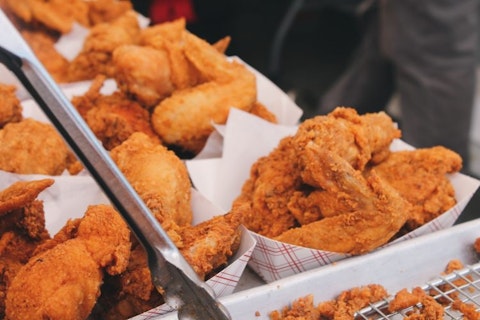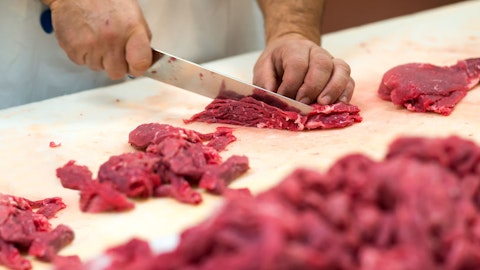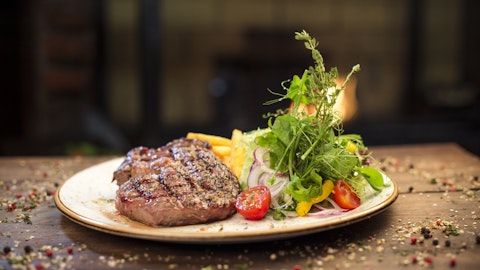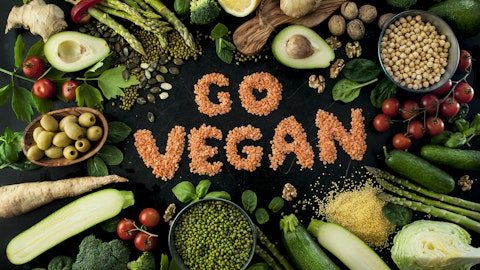Tyson Foods, Inc. (NYSE:TSN) Q3 2023 Earnings Call Transcript August 7, 2023
Tyson Foods, Inc. misses on earnings expectations. Reported EPS is $0.15 EPS, expectations were $0.34.
Operator: Good morning, and welcome to the Tyson Foods Third Quarter 2023 Earnings Conference Call. All participants will be in a listen-only mode. [Operator Instructions] Please also note today’s event is being recorded. At this time, I’d like to turn the floor over to Sean Cornett, from Investor Relations. Sir, please go ahead.
Sean Cornett: Good morning, and welcome to Tyson Foods’ Fiscal Third Quarter 2023 Earnings Conference Call. On today’s call, Tyson’s President and Chief Executive Officer, Donnie King, and Chief Financial Officer, John R. Tyson, will provide some prepared remarks followed by Q&A. Additionally, joining us today are Brady Stewart, Group President, Fresh Meats; Stewart Glendinning, Group President, Prepared Foods; Wes Morris, Group President, Poultry; and Amy Tu, President, International and Chief Administrative Officer. We have also provided a supplemental presentation, which maybe referenced on today’s call and is available on Tyson’s Investor Relations website and via the link in our webcast. During today’s call, we will make forward-looking statements regarding our expectations for the future.
These forward-looking statements made during this call are provided pursuant to the Safe Harbor provisions of the Private Securities Litigation Reform Act of 1995. Forward-looking statements include all comments reflecting our expectations, assumptions or beliefs about future events or performance that do not relate solely to historical periods. These forward-looking statements are subject to certain risks, uncertainties and assumptions, which may cause actual results to differ materially from our current projections. Please refer to our forward-looking statements disclaimers on Slide 2, as well as our SEC filings for additional information concerning risk factors that could cause our actual results to differ materially from our projections.
We assume no obligation to update any forward-looking statements. Please note that references to earnings per share, operating income and operating margin in our remarks are on an adjusted basis, unless otherwise noted. For reconciliations of these non-GAAP measures to their corresponding GAAP measures, please refer to our earnings press release. Now I’ll turn the call over to Donnie.
Donnie King: Thanks, Sean, and thank you to everyone for joining us this morning. Before we review the results, I’d like to start out by discussing my vision for Tyson and the decisive actions that we’re taking to successfully navigate the current market environment. We remain fully committed to our vision of delivering sustainable top-line growth and margin improvement over the long run. With our leadership team, we’re executing a multi-point plan focused on efficiency and modernization, including taking a much closer look at our cost structure across the business to drive operational excellence. We are already seeing tangible benefits of our efforts. We’ve been through market cycles before and I’m confident that we have the right strategy, seasoned leadership and team members in place to emerge stronger from this one.
We’re making good progress and saw sequential improvements in our results in Q3. We’re not yet where we need to be, so we continue to focus on what we can control. Earlier today, we announced our intention to close four more of our chicken facilities demonstrating our commitment to taking bold actions to improve performance. Beyond these important actions, I remain optimistic about our future. We are a leader in our industry and we continue to innovate and take market share in most of our categories. I remain very confident in our long-term strategy, and we are leaving no stone unturned to maximize value for shareholders. Diving into our results, we continue to compare against strong performance across our segments last year. However, I am encouraged by the sequential improvements we made in Q3.
Let me start with Chicken. Market conditions in Chicken are still challenged with commodity prices across most cuts remaining significantly lower, compared to last year. However, adjusted operating income improved by more than a $100 million of one choice without any material benefits as market tailwinds, these sequential increase was primarily due to internal actions we took. For example, in our fiscal Q2, we decided to close two of our plants convert two others to boneless and rationalized our SKUs, inventory, and other assets. In Q3, the team made significant improvements in yield, spend and efficiency, leading to strong improvement in profitability in just one quarter. As we become more productive with automation and team member engagement, we can further optimize our footprint and reallocate resources to more efficient plants, while still having ample capacity to service and grow with our customers.
This enabled us to announce today that we plan to close four additional chicken facilities bringing the total announced closures to six this year. We also recently made the decision to transition away from the “no antibiotics ever” for Tyson branded chicken to a no antibiotics ever important for human medicine approach. Data suggests the use of ionophores can lead to more uniform birds with consistent weight. In turn, we can more accurately forecast supply and demand helping to meet the needs of our customers and consumers. And I want to emphasize that we will continue to evaluate all options including more actions like these across all of our businesses. And beef, we perform better than expected. Our results were driven by our disciplined approach to balancing supply with customer demands, while taking the advantage of seasonal increases in cutout values.
However, the beef industry will likely continue facing headwinds. As you may have seen in the latest USDA cattle inventory report, herd liquidation continues to tighten supply, leading to higher cattle cost, narrowing spreads and difficult export market conditions. Pork remains under pressure across the industry and we continue to see headwinds there with both our internal live production and our external sourced hog supply, increased feed costs and low cut out Stroh spread compression through our results. We also had incremental negative impacts in Q3 from a fire at one of our processing facilities. Finally, to Prepared Foods, which is a key growth pillar for the future. The business performed well in Q3. In Retail, our core business lines saw strong volume growth in the quarter and continue to gain pound and dollar share.
In Broadline Foodservice, Tyson Focus 6 continues to outpace the industry in volume growth. This led to better than anticipated margins in Prepared Foods. In short, our results this quarter demonstrates that Chicken is gaining momentum and our branded Foods business remains an area of strength. Let me add some further color on the performance of our branded business versus our top peers. As I mentioned earlier, our Tyson core business lines, including the iconic retail brands, Tyson, Jimmy Dean, Hillshire Farm and Ball Park continue to outpace total food and beverage, and our peers in volume growth up 5% versus a year ago. We believe this points to the strength of our core brands and sets us up well for the future. We continue to show market share leadership in most of the retail categories, in which we compete, delivering both dollar and pound share growth in the aggregate and across day parts.
Tyson, Jimmy Dean, Hillshire Farms and Ballpark, all hold favorite brand status with consumers over our nearest competitor by a wide margin. Our share performance and brand strength demonstrates the momentum we’ve gained with consumers and they will continue to spend on brands they know and trust. Likewise, we will continue to invest in merchandising and advertising to support our brands. While we are pleased with our brand strength and share performance, we’re constantly building new innovations to expand the appeal and market opportunities for our products. Over the past few years, our innovations have generated roughly $2 billion in annual sales. Let me highlight a few products we’ve launched this fiscal year that I’m most excited about.
Earlier this year, we announced that Tyson Original Chicken Breast Sandwich for retail channels, which won the People Magazine Food Award for Best Frozen Sandwich. Furthermore, we were excited to see that more than 70% of the buyers were new to the Tyson brand and more than 20% were new to the category. We also launched Tyson Chicken Sandwiches in Food Service space where our sandwiches won awards from Food and Beverage Industry, National Agri-Marketing Association, and National Association of Convenience Stores. As you can see, our innovation in chicken is able to be deployed across channels and occasions highlighting the power of our scale. Moving to Jimmy Dean, which is already a clear leader in the breakfast meal occasion, we’re expanding with differentiated capability-based innovation by launching handheld breakfast items.
For instance, this year, we launched the Jimmy Dean biscuit roll-ups in Food Service channel and Maple Grill Cakes and Toaster Pop-Ups in retail. We’re seeing strong customer adoption of these products and promising early consumer demand. In Hillshire Farm, one area of focus in retail has been the trend towards healthy snacking. For instance, we launched Hillshire Farms Snack Kids with 100% real premium meats, cheeses and crackers, all ready to eat on the go. If you haven’t already, I encourage you to try our Snack Kids like Oven-Roasted Turkey Breast, Cheddar Cheese and Wheat Crackers. We launched these products at attractive price points and have already seen strong acceptance with major retail customers. In the food service channel, we are now participating in the fast-growing Cupping Pepperoni category with our very own Hillshire branded Cupping Pepperoni product.
We are always on the lookout for how to keep our brands on trend across channels. Now, I’ll turn things over to John to review our financial results for the quarter in more detail.
John Tyson: Thank you, Donnie. Let me start with a quick summary of our total company results and then review our individual segments. Our sales were down 2.6% year-over-year, driven by pork and chicken where we saw a reduction in price per pound. More than 90% of the decline in adjusted operating profit was driven by lower profitability in our Beef and Chicken segments. Higher input cost per pound was primarily due to the increase in cattle costs along with unfavorable derivative impacts and higher labor costs. But these were partially offset by lower hog costs, reduced outside purchase of meat in our Chicken segment and lower raw material costs in Prepared Foods. While profit was down substantially versus last year, it’s important to note that it improved meaningfully versus last quarter and adjusted EPS increased $0.19 on a sequential basis.
Challenges remain, but we continue to improve efficiencies by controlling what we can and believe we’re heading in the right direction. Now, on to the individual segments results, starting with Beef. In Beef, revenue was essentially flat year-over-year with lower head throughput offset by higher pricing. Operating profit was down primarily reflecting higher cattle costs, which increased $610 million on a lines per pound basis. Operating margin of 1.6% was down from the historically strong, margins of more than 10% in Q3 last year. On a sequential basis, disciplined yield and procurement benefits along with seasonal cutout improvement help drive better than expected operating profits. Beef is likely to continue to face headwinds and we don’t expect the ongoing tightening of cattle supply and spread compression to abate until herd rebuilding is well underway.
Now moving to Pork, revenue was down 18% driven, primarily by lower pricing due to software demand. The operating loss at the quarter was $70 million as spread compression continued to pressure our margins. This was exacerbated by market pressures in our live operations, lower exports and the operational impact of a fire at our Madison facility. Moving on to Chicken now. Sales declined 3.5% year-on-year, driven by lower pricing, partially offset by volume growth. The decrease in pricing reflects the challenging commodity market. While volume grew modestly versus last year, it decreased more than 4% on a sequential basis. This sequential decline is more than historical seasonality reflecting steps we took to allow an internal production to consumer demand, while also reducing finished goods inventory by $70 million.
Year-over-year profitability was negatively impacted by market conditions and higher feed cost and a $65 million net derivative loss in the current quarter, compared to a $23 million loss in the prior year period. On a sequential basis, it’s worth noting the AOI improved by more than a $100 million. In Prepared Foods, sales declined 2.6% driven by both volume and price. The volume decline was driven by Food Service, as the trajectory of this channel’s recovery remains a little uneven. As Donnie mentioned, our Focus 6 categories are outpacing broad line industry and maintaining their share. Our lower foodservice volumes were partially offset by continued growth in retail, highlighting the strength of our brands. Lower pricing was primarily driven by lower bacon prices, reflecting the underlying cutout values for bellies.
Compared to the prior year period, operating profit was up $34 million due to lower raw material cost and productivity gains, which was partially offset by lower sales, higher packaging cost and increased mass investments. Despite increased spending and brand building efforts, we were pleased with our operating margin of 9.2%, particularly so given the challenging retail food environment. Our Prepare Food segment remains key to our strategy providing a high margin, stable business with many growth opportunities ahead helping to offset the pressures and volatility in commodity prices. Before moving on to balance sheet items, I want to provide some context on the goodwill impairment charge that impacted our reported numbers on a GAAP basis, the details of which will be provided in our 10-Q when we file it later this week.
The interim impairment testing we did this quarter resulted in non-cash charges in the reporting units that we have been disclosing is at risk in our filings going back to last fiscal year. The impacts of the charges are not shown in our presentation this morning as they are not reflected in our adjusted results, but all reconciliations to reported results can be found at the appendix. Now, to our financial position and capital priorities, we’re building financial strength, investing in our business and returning cash to shareholders remain the priorities of our capital allocation strategy. Q3 operating cash flow is $660 million, in line with expectations with prudent working capital management, partially offsetting lower profitability. Inventory reduction was the primary driver of improved core working capital.
We still see some opportunity to improve inventory days and drive better cash flow. Year-to-date CapEx is roughly $1.6 billion and we continue to moderate our pace of spending. Based on this pace, we don’t expect CapEx to exceed $2.1 billion below our prior guidance of $2.3 billion. We ended the quarter with $3.7 billion of liquidity and net leverage of 3.2 x. Our balance sheet management approach remains unchanged, as we are committed to building financial strength, maintaining our investment grade credit rating and targeting net leverage of at or below 2 x net debt to EBITDA for the long term. During Q3, we returned $167 million to shareholders via dividends and $11 million in share repurchases. We remain committed to maintaining a disciplined yet opportunistic capital allocation strategy ensuring that we deploy resources to maximize long-term shareholder value.
Now, let’s review our updated outlook for fiscal 2023. We’re maintaining our total company sales guidance range of $53 billion to $54 billion and we expect to be at the lower end with roughly flat sales growth for the year. Turning to AOI, in beef, based on our year-to-date results, offset by anticipated live cattle cutout spread compression, we expect full year margins to be at the higher end of our range of between a loss of 1$ and a gain of 1%. For Pork, due to ongoing market dynamics impacting our Pork segment, we now expect full year margins to be between a loss of 4% and a loss of 2%, but at the higher end of that range. In Chicken, we’re gaining momentum, but with our results year-to-date, including net derivative losses, we expect full year margins to be at the lower end of our range, but between a loss of 1% and a gain of 1%.
Prepared Foods generated strong margins throughout the year with continued investment to support our brands, we expect margins to be at the higher end of the 8% to 10% range for fiscal 2023. And as I mentioned earlier, we’re reducing our expectations for CapEx of approximately $2.1 billion. Our expectations for net interest expense and tax rate remained unchanged at around $340 million and 22% respectively. So, in summary, while the current operating environment is difficult in several of our businesses, we are making improvements across our operations and we are optimistic on our long-term growth opportunities. We have great teams across our segments. We’ve got growing demand for our products and the right portfolio mix to win in the marketplace.
So, now, I’ll turn the call back over to Sean for Q&A instructions.
Sean Cornett: Thanks John. We will now move on to your questions. Please recall, our cautions on forward-looking statements and non-GAAP measures apply both to our prepared remarks and the following QA. Operator, please provide the Q&A instructions.
See also Per Capita Cheese Consumption by Country: Top 25 and 15 Worst Performing Tech Stocks in 2023.
Q&A Session
Follow Tyson Foods Inc. (NYSE:TSN)
Follow Tyson Foods Inc. (NYSE:TSN)
Operator: [Operator Instructions] And our first question today, comes from Alexia Howard from Alliance Bernstein. Please, go ahead with your question.
Alexia Howard: Good morning, everyone.
Donnie King : Good morning.
John Tyson : Good morning.
Alexia Howard: Okay. So, there obviously a lot of moving pieces here on the quarter. Could we maybe take a step back, and get your overall take on the quarter and where we are at in the recovery of your commodity mix segments. Just trying to put things into context here and then I have a follow-up.
Donnie King : Okay. Well, good morning, Alexia. This is Donnie King. Let me start out with thanking you for the question and there is no surprise markets continue to be challenging. And they’re challenging for everyone. I will tell you that we continue to execute our strategy and I would tell you we’ve had for the best execution in our Q3 we’ve had since pre-pandemic times. In Q3, we saw a sequential improvement across all businesses, led by Chicken, as well as – led by chicken as we focused on our cost structure. We have aligned our supply to our demand as we pursue profitable growth. We are controlling the controllables across all businesses. I would tell you that, we’re not surprised by beef and pork results. We expected it.
We are happy to report that we’re winning with customers and consumers and gaining volume and dollar share. We are taking decisive actions, as we talked about this morning, right-sizing and modernizing our footprint, we continue to invest in automation, and digitalization. We continue to invest in our team members and their work experience. We are pursuing growth in value-added and branded categories. In Chicken, behind the number one brand in Chicken, Tyson; in Prepared Foods behind Jimmy Dean, Hillshire Farm and Ball Park. We are number one in eight of nine categories we compete in retail. We hold number one or number two positions in most food service categories. And as I said this morning, we will continue to evaluate everything we do. Tyson has been around since 1935, and I’ve been around since the early 80s, and we’ve seen many cycles before.
We always come out better, stronger, and faster and we will this time, as well. That’s said, we have more to do and we’re excited about our future. Our leadership team and all 140,000 team members are aligned to maximizing shareholder value. That’s a little bit of color. Let me flip it over to Brady as he can speak to a little bit around the Pork and Beef business
Brady Stewart: Sure. Thanks, Donnie. First of all, on the Pork – in our Pork business, I think it’s important to break the Pork business into two different segments. First, as John and Donnie indicated in the opening remarks, we faced some challenges relative to the economics in the Pork business, specific with live operations. It’s well documented that the pork industry is in the midst of a liquidation cycle right now. We believe that the markets will in fact, take care of themselves. But over a half of our losses in the quarter were attributable to live ops and price discovery relative to live ops with some of our suppliers. Fresh pork on the other hand, the other half of that segment was impacted by the fire we had in Madison.
And outside of that, we saw strong improvement in terms of operational execution in our Pork business. We’re excited about the team that we’ve assembled here in Springdale, and believe we have a bright future in front of us as we continue to execute on those operations. On the beef side, we will continue to focus on what we can control relative to you moving through this beef cycle. We’re going to continue to align our supply with demand and drive value-added including Kids Ready to make sure that we continue to be closer to our customer and try to decommoditize that business. Thanks for the question.




